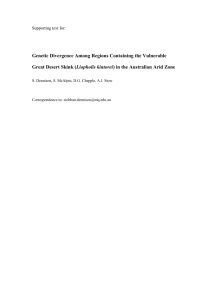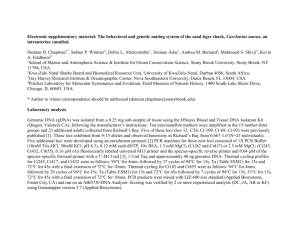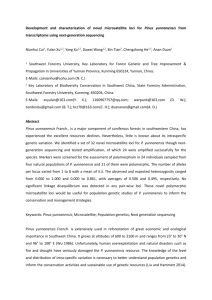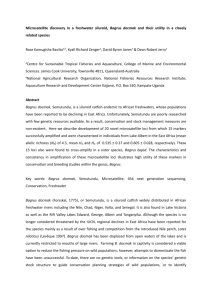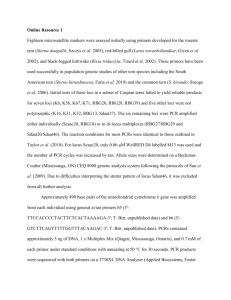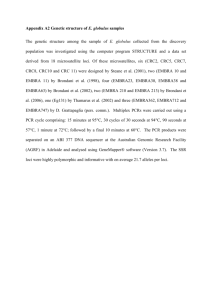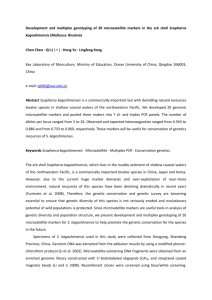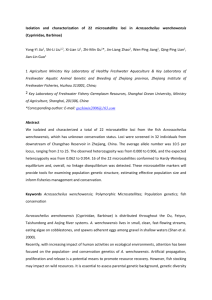Development and characterization of 33 novel polymorphic microsatellite markers for the Boiga irregularis
advertisement
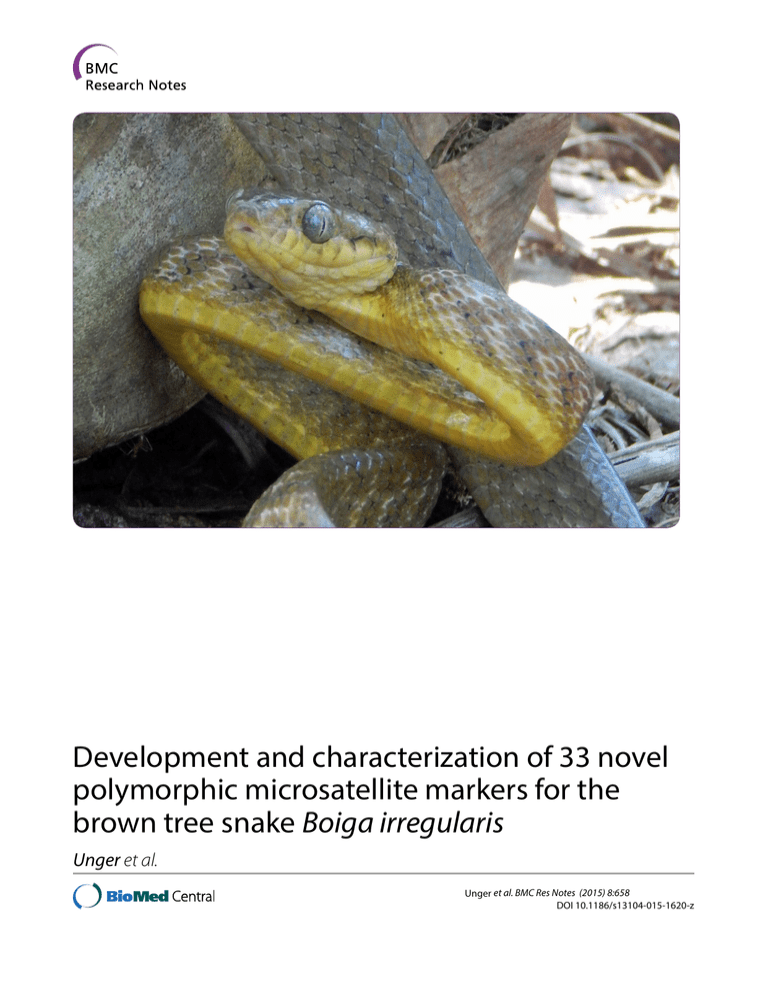
Development and characterization of 33 novel polymorphic microsatellite markers for the brown tree snake Boiga irregularis Unger et al. Unger et al. BMC Res Notes (2015) 8:658 DOI 10.1186/s13104-015-1620-z Unger et al. BMC Res Notes (2015) 8:658 DOI 10.1186/s13104-015-1620-z Open Access SHORT REPORT Development and characterization of 33 novel polymorphic microsatellite markers for the brown tree snake Boiga irregularis Shem D. Unger1*, Erin F. Abernethy1, Stacey L. Lance1, Rochelle R. Beasley1, Bruce A. Kimball2, Thomas W. McAuliffe3, Kenneth L. Jones4 and Olin E. Rhodes Jr.1 Abstract Background: Boiga irregularis is a widespread invasive species on Guam and has led to extirpation of most of the island’s native avifauna. There are presently no microsatellite markers for this invasive species, hence we developed highly polymorphic microsatellite markers to allow for robust population genetic studies on Guam. Findings: We isolated and characterized 33 microsatellite loci for the brown tree snake, B. irregularis. The loci were screened across 32 individuals from Guam. The number of alleles per locus ranged from three to ten, with an average of 4.62. The expected (He) and observed heterozygosity (Ho) ranged from 0.294 to 0.856 and from 0.031 to 0.813, with an average of 0.648 and 0.524, respectively. Significant deviations from Hardy–Weinberg equilibrium were detected at seven loci after Bonferoni correction. Probability of identity values ranged from 0.043 to 0.539. Conclusions: These genetic markers are useful for understanding a suite of post-invasion population genetic parameters, sources of invasions, and effectiveness of management strategies for this invasive species. Keywords: Boiga irregularis, Brown tree snake, Invasive species, Illumina, Microsatellites Findings The brown tree snake Boiga irregularis was inadvertently introduced to the island of Guam following World War II [1] and has devastated native avifauna. There is presently only one study examining the genetic composition of source populations using DNA sequence data from mitochondrial and nuclear sequence loci [2]. Therefore, highly polymorphic multilocus markers are needed to investigate the genetic ramifications of invasive species demography and population genetics of B. irregularis. To investigate the potential use of population genetics tools to inform invasive species management by investigating source populations or determining the current population structure of B. irregularis on Guam, we developed microsatellite markers for B. irregularis. Genomic DNA used to isolate the microsatellite loci was extracted *Correspondence: cryptobranchus11@gmail.com 1 Savannah River Ecology Laboratory, University of Georgia, Aiken, SC 29802, USA Full list of author information is available at the end of the article from one individual, utilizing a QIAamp DNA microkit (QIAGEN). An Illumina paired-end shotgun library was prepared by following the standard protocol of the Illumina nextera DNA sample preparation kit and using a dual index identifier adaptor. Illumina sequencing was conducted on the HiSeq with 100 bp (base pair) pairedend reads. The DNA libraries were prepared to range from 300–600 bp and then paired end reads were performed on the resulting fragments. Thus we sequenced 100 bp from end to end, with primers designed on the reads (one from each) as a majority of the time the two sequences did not overlap, leaving an unknown length of unsequenced bases between the reads. Using the program PAL_FINDER_v0.02.03 [3], 190,804 reads containing tetra, penta, and hexanucleotide repeats were identified and batched to a local installation of the program Primer3 (version 2.0.0) for primer design. Forty-eight primer pairs were tested for amplification and polymorphism following the methods detailed in O’Bryhim et al. [4]. Amplification reactions in 12.5 µl © 2015 Unger et al. This article is distributed under the terms of the Creative Commons Attribution 4.0 International License (http://creativecommons.org/licenses/by/4.0/), which permits unrestricted use, distribution, and reproduction in any medium, provided you give appropriate credit to the original author(s) and the source, provide a link to the Creative Commons license, and indicate if changes were made. The Creative Commons Public Domain Dedication waiver (http://creativecommons.org/ publicdomain/zero/1.0/) applies to the data made available in this article, unless otherwise stated. Unger et al. BMC Res Notes (2015) 8:658 contained 20 ng of genomic DNA, 10 mM Tris pH 8.4, 50 mM KCl, 25.0 µg/ml BSA, 0.4 µM unlabeled primer, 0.04 µM CAG-tag labeled primer, 0.36 µM universal dyelabeled primer, 3.0 mM MgCl2, 0.8 mM dNTPs, using an applied biosystems GeneAmp 9700. The forward primer from each locus was 5′ modified with an engineered “CAG-tag” sequence to enable use of a third, fluorescently labeled primer in PCR following Schuelke 2000 [5]. Touchdown thermal cycling programs encompassing a 10 °C span of annealing temperatures ranging between 65 and 55 °C were used for all loci. Touchdown parameters consisted of an initial denaturation step of 5 min at 95 C followed by 20 cycles of 95 °C for 30 s, highest annealing temperature (decreased 0.5 °C per cycle) for 30 s, and 72 °C for 30 s; and 20 cycles of 95 °C for 30 s, lowest annealing temperature for 30 s, and 72 °C for 30 s, and a final extension at 72 °C for 5 min. PCR products were run on an ABI-3130xl sequencer and sized with Naurox size standard prepared as described in DeWoody et al. [6], except that the unlabeled primer for the Naurox standard was GTTT pig-tailed. Results were analyzed using GeneMapper version 3.7 (Applied Biosystems). Thirty-three of the tested 48 primer pairs amplified high quality PCR product that exhibited polymorphism and consistent allele base pair amplification. We assessed the variability of the 33 polymorphic loci for 32 individuals from Guam. Conditions and characteristics of the loci are provided in Addditional file 1: Table S1. Cervus version 3.0.6 was used to calculate the number of alleles per locus (A) and observed and expected heterozygosity (Ho and He) [7]. All 33 loci were determined to be polymorphic, with a range of 3–10 alleles per locus with an average of 4.62 (Additional file 1: Table S1). Probability of identity (PI) was estimated using GenAlEx v6.5 [8]. Deviations from Hardy–Weinberg equilibrium (HWE) and linkage disequilibrium were performed using GENEPOP v4.0 [9]. After Bonferroni correction for multiple comparisons, eight loci showed significant deviations from HWE (α = 0.00139), and linkage disequilibrium was detected for 1 of the 630 paired loci (α = 0.0000794). Probability of identity values ranged from 0.043 to 0.539. These new microsatellite loci are ideally suited to address important questions including testing the efficacy of management and control techniques for B. irregularis on Guam by providing markers ideal for assessment of population structure before and after eradication efforts. Availability of supporting data The microsatellite sequences are available through the National Centre for Biotechnology Information (see http://www.ncbi.nlm.nih.gov/); GenBank accession no SRR2033931 (submitted 5/20/2015, made public 08/3/2015). Page 3 of 4 Additional file Additional file 1: Table S1. Details for 33 polymorphic microsatellite loci developed for the brown tree snake Boiga irregularis using 32 individuals. Authors’ contributions OER was responsible for the design and implementation of the study, supervision of the work. EA participated in DNA extraction, microsatellite marker validation, and drafting the manuscript. RB participated in data analysis, uploaded microsatellite sequences, and optimization. SL was responsible for data analysis, data interpretation, and drafting the manuscript. BK, TM, and KJ coordinated the field sampling and collecting snake tissue. SU was responsible for optimization of PCR, performing microsatellite laboratory analysis, data analysis, and drafting the manuscript. Sequencing was performed at the University of Colorado Anschutz Medical Campus, Genomics and Microarray Core Laboratory. All authors read and approved the final manuscript. Author details 1 Savannah River Ecology Laboratory, University of Georgia, Aiken, SC 29802, USA. 2 United States Department of Agriculture, Animal and Plant Health Inspection Service, Wildlife Services, National Wildlife Resources Center, Monell Chemical Senses Center, 3500 Market Street, Philadelphia, PA 19104, USA. 3 United States Department of Agriculture, Animal and Plant Health Inspection Service, Wildlife Services, National Wildlife Research Center, P.O. Box 10880, 210 Amau’ulu Road, Hilo, HI 96720, USA. 4 Department of Biochemistry and Molecular Genetics, University of Colorado School of Medicine, Aurora, CO 80045, USA. Acknowledgements We thank the Guam Division of Natural Resources for issuing a Certificate of Origin for collection of samples. Manuscript preparation was partially supported by the DOE under Award Number DE-FC09-07SR22506 to the University of Georgia Research Foundation. Bioinformatics support came from Biostatistics/Bioinformatics Shared Resource of the University of Colorado Cancer Center (5P30CA046934). We thank Kelsey Turner for the Boiga irregularis photography used for the cover image. Competing interests The authors declare that they have no competing interests. Received: 11 June 2015 Accepted: 26 October 2015 References 1. Rodda GH, Fritts TH, Conry PJ. Origin and population growth of the brown tree snake, Boiga iregularis, on Guam. Pac Sci. 1992;46:46–57. 2. Richmond JQ, Wood DA, Stanford JW, Fisher RN. Testing for multiple invasion routes and source populations for the invasive brown tree snake (Boiga irregularis) on Guam: implications for pest management. Biol Invasions. 2015;17:337–9. 3. Castoe TA, Poole AW, de Koning APJ, Jones KL, Tomback DF, OylerMcCance SJ, Fike JA, Lance SL, Streicher JW, Smith EN, Pollack DD. Rapid microsatellite identification from illumina paired-end genomic sequencing in two birds and a snake. Plos ONE. 2012;7(2):e30953. 4. O’Bryhim J, Somers C, Lance SL, Yau M, Boreham, Jones KL, Taylor EB. Development and characterization of twenty-two novel microsatellite markers for the mountain whitefish, prosopium williamsoni and crossamplification in the round whitefish, p. cylindraceum, using paired-end Illumina shotgun sequencing. Conserv Genet Resour. 2013;5:89–91. 5. Schuelke M. An economic method for the fluorescent labeling of PCR fragments. Nat Biotechnol. 2000;18:233–4. 6. DeWoody JA, Schupp J, Kenefic L, Busch J, Murfitt L, Keim P. Universal method for producing ROX-labeled size standards suitable for automated genotyping. Biotechniques. 2004;37:348–52. Unger et al. BMC Res Notes (2015) 8:658 7. Kalinowski ST, Taper ML, Marshall TC. Revising how the computer program CERVUS accommodates genotyping error increases success in paternity assignment. Mol Ecol. 2007;16:1099–106. 8. Peakal R, Smouse PE. GenAlEx 6.5: genetic analysis in excel. population genetic software for teaching and research-an update. Bioinformatics. 2012;28:2537–9. Page 4 of 4 9. Rousset F. Genepop’007: a complete reimplementation of the Genepop software for windows and linux. Mol Ecol Res. 2008;8:103–6. Submit your next manuscript to BioMed Central and take full advantage of: • Convenient online submission • Thorough peer review • No space constraints or color figure charges • Immediate publication on acceptance • Inclusion in PubMed, CAS, Scopus and Google Scholar • Research which is freely available for redistribution Submit your manuscript at www.biomedcentral.com/submit

